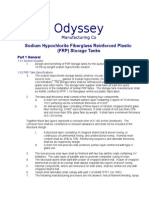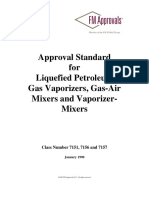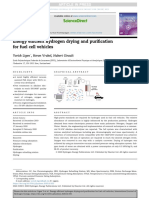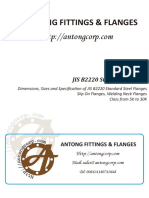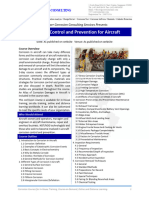0 ratings0% found this document useful (0 votes)
413 viewsAPI 652 Reading Checklist
This document outlines guidelines and best practices for lining the bottoms of aboveground petroleum storage tanks. It covers determining the need for a tank bottom lining, selecting an appropriate lining material, surface preparation requirements, lining application procedures, inspection standards, and evaluating and repairing existing linings. The document provides detailed recommendations for each step of the tank bottom lining process to help ensure corrosion protection and maximize the service life of the lining.
Uploaded by
bacabacabacaCopyright
© © All Rights Reserved
Available Formats
Download as PDF, TXT or read online on Scribd
0 ratings0% found this document useful (0 votes)
413 viewsAPI 652 Reading Checklist
This document outlines guidelines and best practices for lining the bottoms of aboveground petroleum storage tanks. It covers determining the need for a tank bottom lining, selecting an appropriate lining material, surface preparation requirements, lining application procedures, inspection standards, and evaluating and repairing existing linings. The document provides detailed recommendations for each step of the tank bottom lining process to help ensure corrosion protection and maximize the service life of the lining.
Uploaded by
bacabacabacaCopyright
© © All Rights Reserved
Available Formats
Download as PDF, TXT or read online on Scribd
You are on page 1/ 1
API 652 LININGS OF ABOVEGROUND PETROLEUM STORAGE TANK BOTTOMS
READING CHECKLISTS
1 Scope 8 Lining Application
2 Normative References 8.1 General
2.1 Codes, Standards, and Specifications 8.2 Guidelines for Lining Application
2.2 Other References 8.3 Temperature and Humidity Control
3 Terms and Definitions 8.4 Lining Thickness
4 Corrosion Mechanisms 8.5 Lining Curing
4.1 General 9 Inspection
4.2 Chemical Corrosion 9.1 General
4.3 Concentration Cell Corrosion 9.2 Qualification of Inspection Personnel
4.4 Galvanic Cell Corrosion 9.3 Recommended Inspection Parameters
4.5 Microbiologically Influenced Corrosion 10 Evaluation and Repair of Existing Linings
(MIC) 10.1 General
4.6 Erosion-Corrosion 10.2 Evaluation Methods
4.7 Fretting-Related Corrosion 10.3 Evaluation Criteria for Linings
5 Determination of the Need for Tank Bottom 10.4 Evaluating Serviceability of Existing
Lining Linings
5.1 General 10.5 Determining the Cause of Lining
5.2 Linings for Corrosion Prevention Degradation/Failure
5.3 Tank Corrosion History 10.6 Lining Repair and Replacement
5.4 Tank Foundation 11 Maximizing Lining Service Life by Proper
6 Tank Bottom Lining Selection Material Selection and Specification
6.1 General 11.1 General
6.2 Thin-film Tank Bottom Linings 11.2 Lining Material Selection
6.3 Thick-film, Unreinforced Linings 11.3 Written Specification
6.4 Thick-film Reinforced Linings 12 Health, Safety, and Environmental
6.5 Circumstances Affecting Lining 12.1 General
Selection 12.2 Tank Entry
7 Surface Preparation 12.3 Surface Preparation and Lining
7.1 General Application
7.2 Pre-cleaning 12.4 Manufacturer’s Material Safety Data
7.3 Bottom Repair and Weld Preparation Sheets
7.4 Surface Cleanliness
7.5 Surface Profile or Anchor Pattern
7.6 Air and Abrasive Cleanliness
7.7 Removal of Salts
7.8 Removal of Dust
1 of 1
You might also like
- Hourglass Workout Program by Luisagiuliet 276% (21)Hourglass Workout Program by Luisagiuliet 251 pages
- The Hold Me Tight Workbook - Dr. Sue Johnson100% (16)The Hold Me Tight Workbook - Dr. Sue Johnson187 pages
- Read People Like A Book by Patrick King-Edited62% (65)Read People Like A Book by Patrick King-Edited12 pages
- Livingood, Blake - Livingood Daily Your 21-Day Guide To Experience Real Health77% (13)Livingood, Blake - Livingood Daily Your 21-Day Guide To Experience Real Health260 pages
- COSMIC CONSCIOUSNESS OF HUMANITY - PROBLEMS OF NEW COSMOGONY (V.P.Kaznacheev,. Л. V. Trofimov.)94% (212)COSMIC CONSCIOUSNESS OF HUMANITY - PROBLEMS OF NEW COSMOGONY (V.P.Kaznacheev,. Л. V. Trofimov.)212 pages
- Donald Trump & Jeffrey Epstein Rape Lawsuit and Affidavits83% (1016)Donald Trump & Jeffrey Epstein Rape Lawsuit and Affidavits13 pages
- The 36 Questions That Lead To Love - The New York Times94% (34)The 36 Questions That Lead To Love - The New York Times3 pages
- The 36 Questions That Lead To Love - The New York Times95% (21)The 36 Questions That Lead To Love - The New York Times3 pages
- Jeffrey Epstein39s Little Black Book Unredacted PDF75% (12)Jeffrey Epstein39s Little Black Book Unredacted PDF95 pages
- The 4 Hour Workweek, Expanded and Updated by Timothy Ferriss - Excerpt23% (954)The 4 Hour Workweek, Expanded and Updated by Timothy Ferriss - Excerpt38 pages
- SB-165 - ASME BPVC 2021 Sección II Part BNo ratings yetSB-165 - ASME BPVC 2021 Sección II Part B6 pages
- ASME B31.8 Gas Transmission & Distribution Piping SystemsNo ratings yetASME B31.8 Gas Transmission & Distribution Piping Systems3 pages
- ASTM D1265 Sampling Liquefied Petroleum Gases (Manual Method)100% (1)ASTM D1265 Sampling Liquefied Petroleum Gases (Manual Method)2 pages
- Understanding API SIRE Reading 1 Part 2 of 2No ratings yetUnderstanding API SIRE Reading 1 Part 2 of 254 pages
- English-GB T23257-2017-Polyethylene Coating For Buried Steel PipelineNo ratings yetEnglish-GB T23257-2017-Polyethylene Coating For Buried Steel Pipeline66 pages
- Selection and Use of ASTM Standards For The Determination of Flash Point of Chemicals by Closed Cup MethodsNo ratings yetSelection and Use of ASTM Standards For The Determination of Flash Point of Chemicals by Closed Cup Methods6 pages
- NORSOK R-004 2005 (Draft) Piping and Equipment InsulationNo ratings yetNORSOK R-004 2005 (Draft) Piping and Equipment Insulation30 pages
- MSS SP-55 (Quality Standard For Steel Casting Valve, Flange, Fitting, Etc.No ratings yetMSS SP-55 (Quality Standard For Steel Casting Valve, Flange, Fitting, Etc.23 pages
- 41-Stacks and Flares Inspection ChecklistNo ratings yet41-Stacks and Flares Inspection Checklist4 pages
- Integrity Testing Above Ground Storage TanksNo ratings yetIntegrity Testing Above Ground Storage Tanks39 pages
- Evaluation of Underground Storage Tank LinersNo ratings yetEvaluation of Underground Storage Tank Liners14 pages
- PT2SB-MNT-WI-060 Thickness Measurement Via Ultrasonic Testing & Thickness Measurement Location Corrosion - R1No ratings yetPT2SB-MNT-WI-060 Thickness Measurement Via Ultrasonic Testing & Thickness Measurement Location Corrosion - R119 pages
- OIL - AE - ICDA - PrA - Report - Line#26 - 02 - FINALNo ratings yetOIL - AE - ICDA - PrA - Report - Line#26 - 02 - FINAL26 pages
- Checklist For Above Ground Tanks-QueenslandNo ratings yetChecklist For Above Ground Tanks-Queensland2 pages
- Seamless Carbon Steel Boiler Tubes For High-Pressure ServiceNo ratings yetSeamless Carbon Steel Boiler Tubes For High-Pressure Service2 pages
- API 653 - Section 650 Flash Card - 36 QuestionsNo ratings yetAPI 653 - Section 650 Flash Card - 36 Questions5 pages
- Cosasco RBS - Rbsa Retriever MaintenanceNo ratings yetCosasco RBS - Rbsa Retriever Maintenance44 pages
- S1474001-General Requirements For Testing of Pipe SystemsNo ratings yetS1474001-General Requirements For Testing of Pipe Systems20 pages
- 650-680 Rev 4 - Hydrostatic Test ExemptionsNo ratings yet650-680 Rev 4 - Hydrostatic Test Exemptions3 pages
- ASTM G62 Standard Test Methods For Holiday Detection in Pipeline CoatingsNo ratings yetASTM G62 Standard Test Methods For Holiday Detection in Pipeline Coatings4 pages
- Dimensions, Sizes and Specification of JIS B2220 Standard Steel Flanges PDFNo ratings yetDimensions, Sizes and Specification of JIS B2220 Standard Steel Flanges PDF8 pages
- Design Standard: DIN EN ISO 4126-1: Design of Safety ValvesNo ratings yetDesign Standard: DIN EN ISO 4126-1: Design of Safety Valves21 pages
- API 570 Interview Questions and Answers: Essential Guide for Piping InspectorsFrom EverandAPI 570 Interview Questions and Answers: Essential Guide for Piping InspectorsNo ratings yet
- API 510 Interview Questions and Answers: The Essential Guide for Pressure Vessel InspectorsFrom EverandAPI 510 Interview Questions and Answers: The Essential Guide for Pressure Vessel InspectorsNo ratings yet
- Corrosion Control and Prevention For AircraftNo ratings yetCorrosion Control and Prevention For Aircraft3 pages
- Storage Tank Design: Email:moemen - Hussein@alexu - Edu.eg100% (1)Storage Tank Design: Email:moemen - Hussein@alexu - Edu.eg58 pages
- Alarm Management KPI Utilizing IMS in Offshore PlatformsNo ratings yetAlarm Management KPI Utilizing IMS in Offshore Platforms91 pages
- BS 10500 Anti-Bribery Management It's Your ReputationNo ratings yetBS 10500 Anti-Bribery Management It's Your Reputation16 pages
- Scaffolder: Construction Job Description 5No ratings yetScaffolder: Construction Job Description 51 page
- Calcium Cyanide: Hydrogen Cyanide. CONSULT THE NEW JERSEYNo ratings yetCalcium Cyanide: Hydrogen Cyanide. CONSULT THE NEW JERSEY6 pages
- Analisis Kapasitas Daya Dukung Cerucuk Pada Tanah Gambut Dan Lunak Di Kabupaten SiakNo ratings yetAnalisis Kapasitas Daya Dukung Cerucuk Pada Tanah Gambut Dan Lunak Di Kabupaten Siak17 pages
- XX X XXXX XX XXXX - Tank Foundation 45m Dia X 25m High On Earthen Bund FoundationNo ratings yetXX X XXXX XX XXXX - Tank Foundation 45m Dia X 25m High On Earthen Bund Foundation44 pages










































